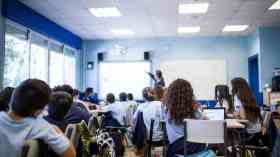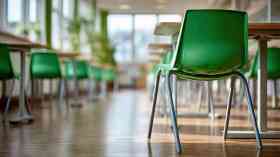
The need for a national clean air strategy for schools
While a range of solutions to reducing air pollution in and around schools exist, there is little guidance to help schools implement them. That’s why leading experts from the ‘Tackling Air Pollution At School’ (TAPAS) network are calling for a clean air strategy for schools. Dr Katherine Roberts explains further
Polluted air, in the classroom, in the playground, or to and from school on the school run, is a serious threat to children’s health and their ability to learn. School buildings and the sites they are located on are not always fit for purpose and identifying ways to reduce air pollution inside and out pose various challenges.
The scale of the problem of air pollution in the UK is reported in the latest ‘Annual Report: Air Pollution’, published by England’s Chief Medical Officer (CMO) Professor Chris Witty. This report draws on the experience and research of a large community of air pollution experts, many of whom are involved with the TAPAS (Tackling Air Pollution At School) network.
TAPAS is a network of experts working together to understand air quality in and around schools. Funded as part of the Strategic Priorities Fund Clean Air Programme, the network brings together stakeholders across academia, education, public policy, civil society and business and is working towards engaging better with schools to improve public understanding of the effects of air pollution.
Raising awareness of the harmful effects
The COVID-19 pandemic highlighted many gaps in public knowledge when considering indoor environmental conditions, particularly the important role clean air can play in reducing the spread of disease. Informing teachers and teaching children about air pollution and how their behaviour can influence positive change, for example switching the school run from the car to walking or cycling or improving ventilation and flushing out pollutants by opening a window, is an important step in raising awareness. But as highlighted in the CMO report, more must be done to also address our gaps in scientific knowledge.
The CMO report states that “the current awareness of ventilation and actions such as providing CO2 monitors to schools provides opportunities to bring education on healthy environments into the national curriculum alongside other health and environmental measures including energy, sustainability, healthy eating and physical activity”.
Dr Henry Burridge, senior lecturer at Imperial College London and contributing author to the CMO report said: “Professor Witty’s report emphasises the importance of indoor air quality, and schools are somewhere that our young people spend a large portion of their time – their exposure to air pollution in and around schools, and the understanding that they gain about air pollution from their learning at school, are important for determining the impacts of air pollution on our next generation.”
A range of interventions
The CMO report showcases several studies in the UK that are being implemented to help reduce air pollution and improve children’s health. These programmes support measures, such as the installation of green screens and air filtration systems, the implementation of ‘school streets’ to restrict car access outside the school gates, building equipment upgrades and behaviour change campaigns, which have all helped reduce emissions from schools and children’s exposure to air pollution.
While all these contributions are a significant defence in our fight against air pollution, they could be viewed as a band aid approach to a global problem that should be being dealt with through government legislation. Professor Prashant Kumar, founding director of the Global Centre for Clean Air Research (GCARE) and contributing TAPAS researcher says: “The best way to limit the exposure to children is to control the air pollutant emissions at the source.”
Professor Kumar goes on to say that “once pollutants are released into the environment, different types of interventions such as those described in the CMO report become important.” The GCARE team have tested many of these interventions in real-world situations. Prof Kumar suggests that “a mix of interventions could be a way to maximise their benefits”.
The need for collaboration
To reduce air pollution in and around schools, many different organisations will need to come together to work collaboratively and take responsibility for providing clean air. Larissa Lockwood, TAPAS co-investigator and director of Clean Air at Global Action Plan, is leading the call for a national clean air strategy for schools. She said: “Air pollution can damage children’s health and ability to learn. What is clear from the CMO’s Annual Report and the work of the TAPAS Network is that solutions to reducing air pollution in and around schools do exist. Unfortunately, no one is taking responsibility to help schools implement these solutions. It is therefore crucial that a national clean air strategy sets out a focused route to improve the air our children breathe when at school.”
A vision of the TAPAS network is for schools to be empowered to reduce their own exposure to pollution. By giving staff, students and parents the correct tools and knowledge, we can equip them to tackle air pollution in and around their schools.
By bringing together air pollution experts, healthcare professionals, engineers, campaigners, policy makers, teachers, parents and most importantly children, we can pave the way for a healthier, cleaner future and inspire the next generation of young minds.
About the author
Dr Katherine Roberts is the network manager for the ‘Tackling Air Pollution at Schools’ (TAPAS) Network based at the University of Cambridge. She also works part time as a Research Associate at Imperial College London for the SAMHE project (Schools’ Air Quality Monitoring for Health and Education) and the ‘Future Urban Ventilation Network’. Dr Roberts is a chartered building services engineer with over eight years’ experience working as part of an environmental physics team for a global engineering consultancy firm.
Latest News
07/11/2025 - 09:54
The Scottish Government has announced funding which will go to local councils for strategic approaches to closing the poverty-related attainment gap.
06/11/2025 - 09:42
Ofsted has shared findings from pilot inspections carried out in 115 schools this autumn, ahead of the full rollout of its renewed inspection framework.
06/11/2025 - 09:16
The TV, radio and multi media campaign deals with the root causes of absences and identifies ways to approach conversations about wellbeing that can help pupils to improve their attendance.
05/11/2025 - 09:49
The government will publish a new set of enrichment benchmarks, with schools asked to ensure every child has access to activities across five categories of enrichment.
05/11/2025 - 09:37
For the first time, primary aged children will gain vital skills like how to spot fake news and identify misinformation and disinformation.







